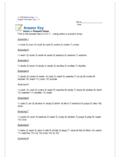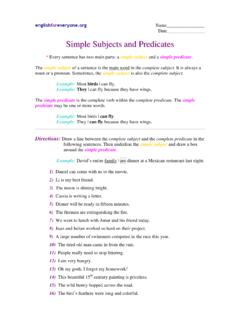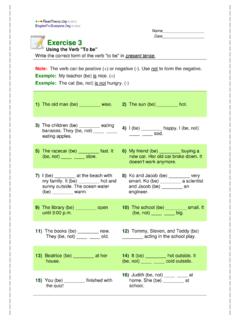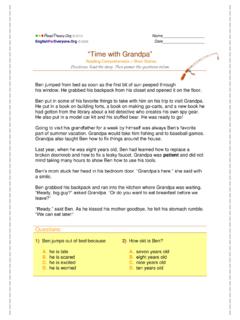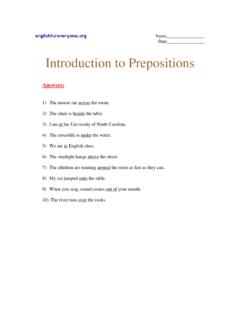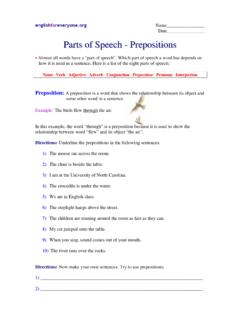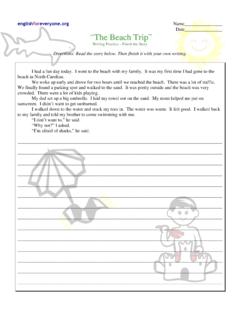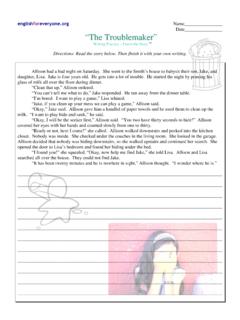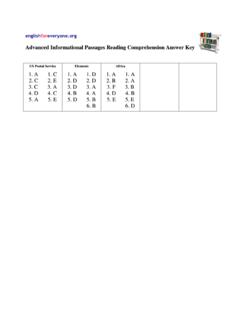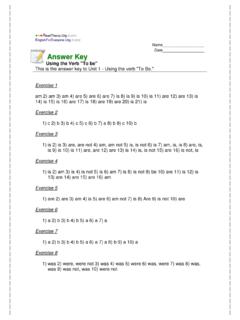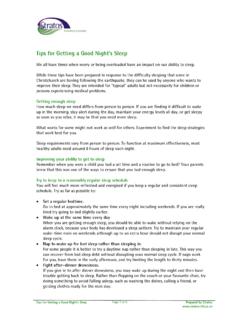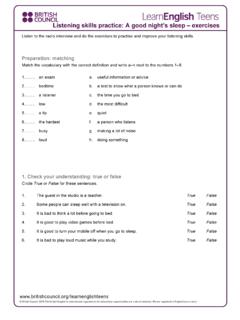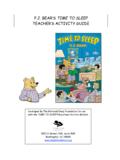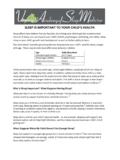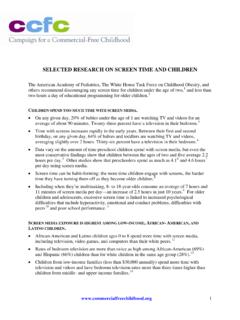Transcription of Informational Passages RC - Sleep - English Worksheets
1 Name_____ Date_____ SSlleeeepp Reading Comprehension Informational Passages Directions: Read the passage. Then answer questions about the passage below. Wake up! Do you hear these words often? If so, maybe you are not getting enough Sleep . What is Sleep ? Why do people Sleep ? How much Sleep do you need? All people Sleep . All mammals and birds also Sleep . Some reptiles, amphibians, and fish Sleep too. Scientists understand some of the reasons for Sleep . But they do not understand everything about it. There are two kinds of Sleep in mammals and birds. One kind of Sleep is Rapid Eye Movement Sleep , which we call REM Sleep . The other kind of Sleep is Non Rapid Eye Movement Sleep , which we call NREM or non REM Sleep . The American Academy of Sleep Medicine divides NREM Sleep into three ssttaaggeess: N1, N2, and N3 Sleep .
2 When people first go to Sleep , they are in NREM Sleep . The first stage of NREM Sleep is N1 Sleep . During N1 Sleep , people get very drowsy. Some people have muscle twitches during this part of Sleep . People are not very ccoonnsscciioouuss of, or aware of, their surroundings during this stage of Sleep . Brain monitors identify small, slow, and irregular brain waves during N1 Sleep . The second stage of Sleep is N2 Sleep . People are not at all conscious of their surroundings during N2 Sleep . About 45%-55% of total adult Sleep is N2 Sleep . Brain monitors identify large brain waves with quick bursts of activity during N2 Sleep . The third stage of Sleep is N3 Sleep . It is very deep Sleep . Brain monitors identify very slow brain waves during N3 Sleep . Therefore, N3 Sleep is called slow wave Sleep (SWS.) After N3 Sleep , people cycle back to lighter N2 Sleep before going into REM Sleep .
3 People cycle through the stages of NREM Sleep 4 or 5 times each night and enter REM Sleep several times during one night. Dreams occur during REM Sleep and the eyes move quickly beneath closed eyelids. During REM Sleep , people and animals are ppaarraallyyzzeedd. Scientists think people enter a state in which they cannot move so they will not hurt themselves while they are dreaming. The National Sleep Foundation in the United States says that 7 9 hours of Sleep daily is best for an adult. Seven to nine hours of Sleep is good for memory, alertness, problem solving, and health. Less than six hours of Sleep affects the ability to think. Getting too much Sleep may not be good for people either. Too much Sleep is linked to sickness and depression. Babies need a lot more Sleep than adults. A newborn infant needs up to 18 hours of Sleep each day.
4 A baby spends about nine hours in REM Sleep . Five year olds need 11 13 hours of Sleep each day. A five year old spends about 2 hours in REM Sleep . Teenagers need 9 10 hours of Sleep each day. Pregnant women need more Sleep than other adults. Many people think that eellddeerrllyy people need less Sleep than younger adults, but that is not true. Most adults do well with 7 9 hours of Sleep . Scientists are not sure of all the reasons for Sleep . They know that Sleep helps the body heal and grow. Sleep helps the immune system which helps people fight disease. Sleep helps the iinnffaanntt brain grow. It seems that REM Sleep is especially important for babies brain growth. It also seems that Sleep is a time for processing memories. Why do we dream? Some scientists believe that dreams have a psychological purpose. Some think that dreams help organize our brains.
5 Some think that dreams are the result of random brain activity during REM Sleep . Sleep patterns differ substantially from culture to culture. Cultures with aarrttiiffiicciiaall light have different Sleep patterns from cultures without artificial light (like electric lamps.) In cultures that use artificial light, people usually go to Sleep later at night, and they Sleep through the night. In other cultures, people often Sleep for two periods. They go to Sleep shortly after the sun goes down. They Sleep deeply for several hours. Then, they tend to wake up for several hours. Afterward, they go to Sleep again for several more hours. In hunter gatherer groups, people Sleep off and on throughout the day and night. People Sleep in a variety of places, too. Some people Sleep on the ground. Some Sleep on mats or in beds. Some use pillows, blankets, and other bedding.
6 But they all Sleep ! Good night! Sweet dreams! QQuueessttiioonnss:: 11)) WWhhaatt hhaappppeennss dduurriinngg RREEMM sslleeeepp?? A. The sleeper dreams. B. The sleeper becomes paralyzed. C. The sleeper s eyes move rapidly. D. All of the above are correct. E. Both A and C are correct. 22)) HHooww mmuucchh sslleeeepp sshhoouulldd aann aadduulltt ggeett?? A. 6-8 hours. B. 8 hours. C. 7-9 hours. D. At least 9 hours. E. As much as possible. 33)) WWhhiicchh ggrroouupp nneeeeddss tthhee mmoosstt sslleeeepp?? A. Babies B. Teenagers C. Adults D. Pregnant women E. Elderly adults 44)) WWhhaatt aarree ssoommee ooff tthhee kknnoowwnn rreeaassoonnss wwhhyy ppeeooppllee sslleeeepp?? A. In order to grow B. In order to stay healthy C. In order to fight sickness D.
7 In order to improve problem solving E. All of the above 55)) WWhhyy ddoo ppeeooppllee ddrreeaamm?? A. Dreams might help organize our brains. B. Dreams might be random brain activity. C. Dreams might have a psychological purpose. D. Dreams might reenergize your body. E. A and B are correct. F. A, B, and C are correct. VVooccaabbuullaarryy:: 11)) SSttaaggeess A. time periods. B. eras in history. C. memories. D. reasons. E. drawn out situations. 22)) IIff yyoouu aarree ccoonnsscciioouuss ooff ssoommeetthhiinngg,,.. A. you know about it. B. you are aware of it. C. you have trouble thinking. D. Both A and B are correct. E. Both A and C are correct. 33)) IIff yyoouu aarree ppaarraallyyzzeedd,, A. cannot Sleep . B. cannot move. C. do not dream. D. do not understand.
8 E. do not fight sickness. 44)) TThhee bbeesstt ssyynnoonnyymm ffoorr eellddeerrllyy ppeeooppllee A. babies. B. children. C. teenagers. D. older adults. E. pregnant women. 55)) WWhhaatt iiss aann iinnffaanntt?? A. A newborn baby B. A young child C. An adult D. Both A and B are correct. E. Both A and C are correct. 66)) IIff ssoommeetthhiinngg iiss aarrttiiffiicciiaall,, iitt A. realistic. B. true. C. non-natural. D. non-human. E. non-functional.
